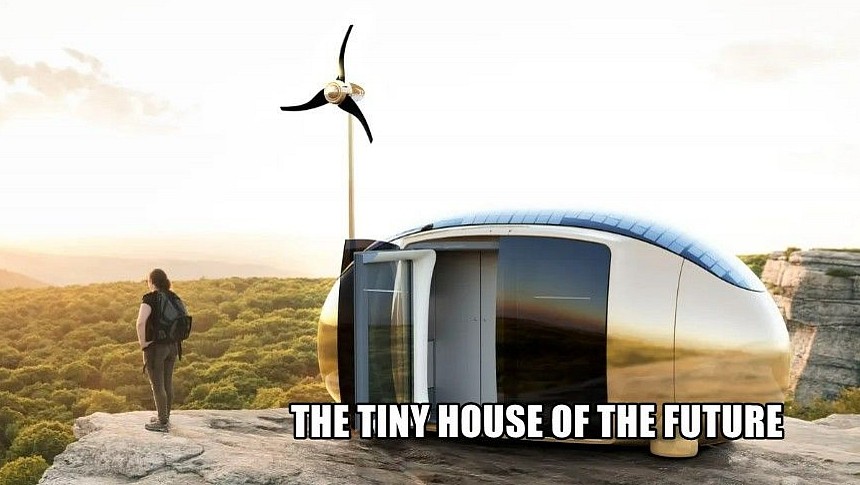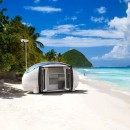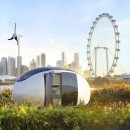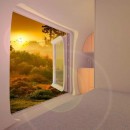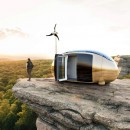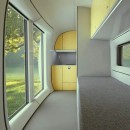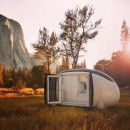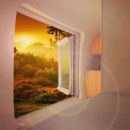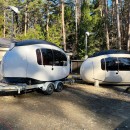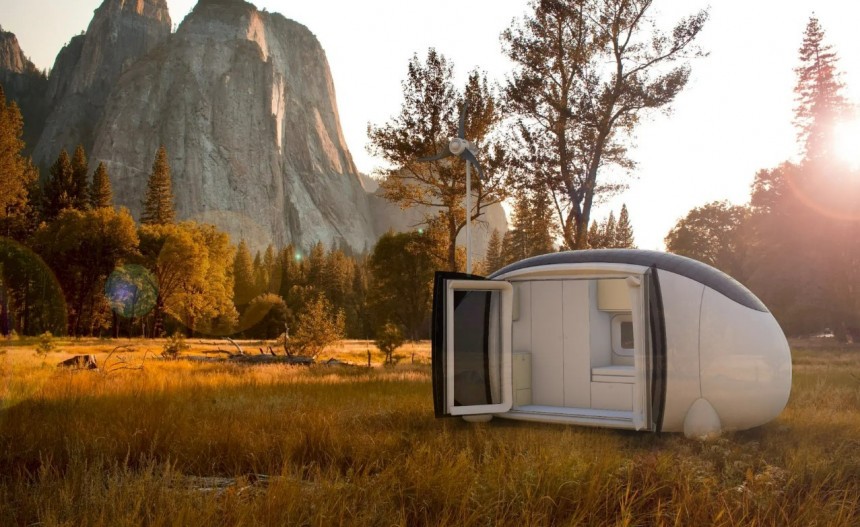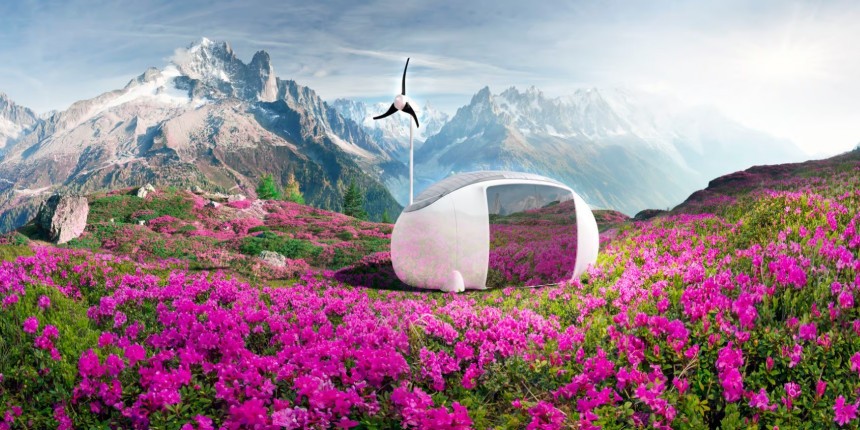Some people like their eggs fried, others hard-boiled. A very small number of people like their eggs habitable, self-sufficient, very eco-friendly, and, more importantly, highly mobile. Those people are Ecocapsule owners.
Ecocapsule is a very unique tiny home that boasts all the qualities mentioned above. It's very compact and has a reduced carbon footprint both due to its size and production, it's self-sufficient and eco-friendly, and very mobile because it can be moved from location to location by simply plopping it onto a trailer. The Ecocapsule, often referred to as the tiny home of the future, is now back with a fresh iteration.
The Ecocapsule is the creation of architects Tomas Zacek and Sona Pohlova, who started out as Nice Architects and now go by Nice & Wise. The idea for it was introduced as a concept study in 2014, followed by a scale model in 2015, and, following incredible – and incredibly positive – feedback, the first prototype in 2016. NextGen is technically the third model in the lineup, though all three are the same model with some variations.
The Original Ecocapsule is the flagship model, while Space is the stripped-down version. The NextGen is the updated and upgraded version, which brings a different interior layout and a slightly larger frame that allows for more storage and a larger interior.
The Ecocapsule takes the sustainable approach and combines it with the concept of downsizing to create the perfect, modern, mobile house for today's city dweller. It's an egg-shaped structure that, despite the high mobility claim, doesn't move under its own power. However, it's light enough that it can be moved by trailer, packed inside a shipping container, or even hauled by helicopter to the top of a mountain if that's your thing and you have the budget for it.
The house looks like an egg, but it sits on four legs that give it stability on most terrains. The shell is fiberglass over a steel frame, and it features a double door and a single window on the opposite side. The roof is covered in solar cells, and there's a retractable wind turbine on one end for generating electricity throughout the day.
The rounded exterior also helps with rainwater collection, so the Ecocapsule comes with its own water treatment and filtration system. Between the ability to generate drinking water, to create its own electricity, and the waterless separating toilet, the Ecocapsule remains off the grid for as long as you want, or supplies last.
NextGen is all these things as well, but it is better to be worthy of the name. It's longer than its predecessor, the Original, by 0.53 meters (1.7 feet), so it's now 5.2 meters long (17 feet). It still fits inside a shipping container for transport, though.
The floor is lower than in the Original because the battery and water system previously housed there have been moved to two exterior system compartments. This allows for new storage options: Nice & Wise estimates there'll be at least 550 liters (19.4 cubic feet) more of storage space available with this upgrade.
The production process has also been streamlined and optimized to allow for faster production rates but reduced costs. The layout is different, following feedback from existing customers and the larger Ecocapsule fanbase and aiming for easier assembly and lower costs. The maker notes that a curved shelf in the Original model will be discontinued, while the dining table on the wall will move under the bed, from whence it will appear only when needed.
Nice & Wise is exploring "alternative materials and plastics" for furniture in a move to create biodegradable furniture that's lighter and cheaper but without losing any points in terms of quality or craftsmanship.
For the time being, the only look inside the cabin shows the same kind of sleek, minimalist furniture that is more in tune with Scandinavian functionality than the general understanding of luxury.
Given the very compact footprint, the layout is essentially the same, but with some changes that make it feel different. The double door now swings open like a regular door (the Original had gullwing doors), opening the interior to the outside. You have the small kitchen to the left at the end of the capsule and the bathroom right in front. The other end of the pod is taken up by the lounge area, which becomes a bedroom at night.
The NextGen model was introduced in March this year, but details like the full spec list or pricing are still unavailable. The Original had 880W of solar cells and an additional 750W from the wind turbine, so we reckon these still apply to the NextGen. Changes to the overall weight should be expected since NextGen was specifically designed with weight reduction in mind.
As a point of reference, the Original Ecocapsule starts at €99,900 (approximately $104,700 at the current exchange rate), while the Space is €69,900 ($73,250) and goes higher as you personalize it. NextGen should go into production next year, which is when we'll find out more details about it.
But one thing's certain: these tiny homes might be all these amazing things, but they're not affordable. They're still very popular with glamping units and private individuals looking for a tiny home like no other. Actress Susan Sarandon owns one, which she had shipped to a plot of land in Costa Rica where she wasn't allowed to build anything more traditional.
The Ecocapsule is the creation of architects Tomas Zacek and Sona Pohlova, who started out as Nice Architects and now go by Nice & Wise. The idea for it was introduced as a concept study in 2014, followed by a scale model in 2015, and, following incredible – and incredibly positive – feedback, the first prototype in 2016. NextGen is technically the third model in the lineup, though all three are the same model with some variations.
The Original Ecocapsule is the flagship model, while Space is the stripped-down version. The NextGen is the updated and upgraded version, which brings a different interior layout and a slightly larger frame that allows for more storage and a larger interior.
The house looks like an egg, but it sits on four legs that give it stability on most terrains. The shell is fiberglass over a steel frame, and it features a double door and a single window on the opposite side. The roof is covered in solar cells, and there's a retractable wind turbine on one end for generating electricity throughout the day.
The rounded exterior also helps with rainwater collection, so the Ecocapsule comes with its own water treatment and filtration system. Between the ability to generate drinking water, to create its own electricity, and the waterless separating toilet, the Ecocapsule remains off the grid for as long as you want, or supplies last.
The floor is lower than in the Original because the battery and water system previously housed there have been moved to two exterior system compartments. This allows for new storage options: Nice & Wise estimates there'll be at least 550 liters (19.4 cubic feet) more of storage space available with this upgrade.
The production process has also been streamlined and optimized to allow for faster production rates but reduced costs. The layout is different, following feedback from existing customers and the larger Ecocapsule fanbase and aiming for easier assembly and lower costs. The maker notes that a curved shelf in the Original model will be discontinued, while the dining table on the wall will move under the bed, from whence it will appear only when needed.
For the time being, the only look inside the cabin shows the same kind of sleek, minimalist furniture that is more in tune with Scandinavian functionality than the general understanding of luxury.
Given the very compact footprint, the layout is essentially the same, but with some changes that make it feel different. The double door now swings open like a regular door (the Original had gullwing doors), opening the interior to the outside. You have the small kitchen to the left at the end of the capsule and the bathroom right in front. The other end of the pod is taken up by the lounge area, which becomes a bedroom at night.
The NextGen model was introduced in March this year, but details like the full spec list or pricing are still unavailable. The Original had 880W of solar cells and an additional 750W from the wind turbine, so we reckon these still apply to the NextGen. Changes to the overall weight should be expected since NextGen was specifically designed with weight reduction in mind.
But one thing's certain: these tiny homes might be all these amazing things, but they're not affordable. They're still very popular with glamping units and private individuals looking for a tiny home like no other. Actress Susan Sarandon owns one, which she had shipped to a plot of land in Costa Rica where she wasn't allowed to build anything more traditional.
